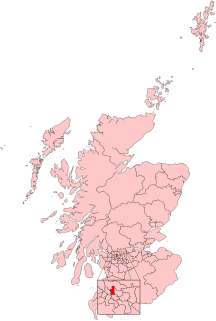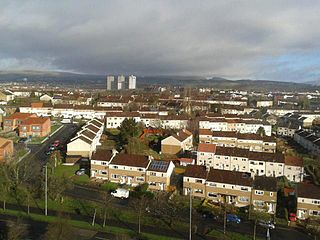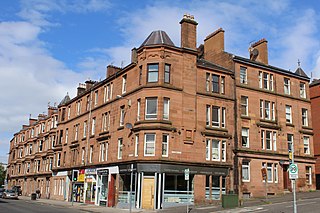
Scotstoun is an area of Glasgow, Scotland, west of Glasgow City Centre. It is bounded by Garscadden and Yoker to the west, Victoria Park, Jordanhill and Whiteinch to the east, Jordanhill to the north and the River Clyde to the south. At the heart of Scotstoun lies Scotstounhill, an enclave of late Victorian and post-war housing centred on Scotstounhill railway station. Scotstoun is home to BAE Systems Surface Ships, and to the Glasgow Warriors rugby team.

Knightswood is a suburban district in Glasgow, containing three areas: Knightswood North or High Knightswood, Knightswood South or Low Knightswood, and Knightswood Park. It has a golf course and park, and good transport links with the rest of the city. Garscadden and Scotstounhill railway stations serve Low Knightswood while Westerton station serves High Knightswood. Knightswood is directly adjoined by the Anniesland, Blairdardie, Drumchapel, Garscadden, Jordanhill, Netherton, Scotstoun, Scotstounhill and Yoker areas of Glasgow, and by Bearsden in the north.

Hyndland is a residential area in the West End of the city of Glasgow, Scotland.

North Kelvinside is a residential district of the Scottish city of Glasgow.

Glasgow North is a burgh constituency of the House of Commons of the Parliament of the United Kingdom. It elects one Member of Parliament (MP) by the first-past-the-post voting system.

Cleveden Secondary School is a school located in Kelvinside in the West End of Glasgow.

Croftfoot is a residential area on the southeastern side of the Scottish city of Glasgow. It is bordered by Castlemilk to the south and King's Park to the west within Glasgow, and by the Rutherglen areas of Spittal to the east and Bankhead to the north. Historically within the civil parish of Cathcart in Renfrewshire, it is within the Linn ward of Glasgow City Council.

Temple is a neighbourhood of Glasgow located in the north of the city, bounded by Anniesland to the south, Knightswood to the west and Kelvindale to the east; Netherton lies to the north. Temple appears in Joan Blaeu's 1662 Atlas of Scotland and many subsequent maps.

Anniesland is a district in the West End of the Scottish city Glasgow. It is situated north of the River Clyde, and centres on the major road junction of the Great Western Road (A82) and Crow Road/Bearsden Road (A739), known as Anniesland Cross.

Broomhill is a district in the West End of the city of Glasgow, Scotland. North of the River Clyde, it is bounded by the districts of Thornwood and Partick to the south, Hyndland to the east, and Jordanhill, Scotstoun and Victoria Park to the west.

Blairdardie is a neighbourhood in the Scottish city of Glasgow. It is situated north of the River Clyde in the north-west of the city and is surrounded by other residential areas: High Knightswood, Knightswood, Old Drumchapel, Drumchapel and Garscadden. It was built between the 1950s and early 1960s.
The Stobcross Railway was a railway line built by the North British Railway to connect from Maryhill to the new dock being built at Stobcross; the dock became the Queen's Dock, opened in 1877. The line was opened first, in 1874, and gave the North British company access to the north bank of the River Clyde; there was a goods depot at Partick.

King's Park is a district in the city of Glasgow, Scotland. It is situated south of the River Clyde and borders the Glasgow areas of Croftfoot, Cathcart, Simshill, Mount Florida and Toryglen and the neighbourhood of Bankhead in the adjoining town of Rutherglen.

Hyndland Secondary School is a non-denominational state comprehensive school in the Hyndland area of Glasgow, Scotland.

Partickhill is a district of the city of Glasgow. Located to the north of Partick, south of Hyndland and west of Dowanhill, it contains mixed housing stock of tenemental type property and villa style houses, as well as some terraced homes.

Thornwood is a largely residential area of Glasgow, Scotland, lying north of the River Clyde. Part of the city's West End, it is situated almost on the river between Partick to the east and south and Broomhill to the north and west; the neighbourhoods of Whiteinch, Glasgow Harbour and Hyndland are also fairly close.

Glasgow, the largest city in Scotland, has several distinct styles of residential buildings, and since its population began to grow rapidly the 18th century has been at the forefront of some large-scale projects to deal with its housing issues, some of which have been assessed as being largely successful and others less so.

Victoria Park is one of the 23 wards of Glasgow City Council. Created as Partick West in 2007 it returned four council members, using the single transferable vote system; the boundaries were unchanged in 2012. For the 2017 Glasgow City Council election, the boundaries were changed, the ward decreased in size and population, was re-named Victoria Park and returned three members.

Partick East/Kelvindale is one of the 23 wards of Glasgow City Council; used since the 2017 local election, it is one of two created from the Local Government Boundary Commission for Scotland's 5th Review. The ward returns four council members.


















